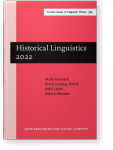Dissimilatory constraints discriminate between variants in analogical change
Louise Esher | CNRS (Langage, Langues et Cultures d’Afrique, UMR 8135)
This study presents evidence that dissimilatory constraints act as a discriminating factor in the selection
of models for analogical change within inflectional paradigms. The study compares the lexical extension of root-final /ɡ/ in
preterite forms in two groups of Occitan varieties: one group with established preterite desinences in -/εɡ/-, where
introducing /ɡ/-final roots creates a sequence -/ɡεɡ/-; and another group with established preterite desinences in -/εɾ/-,
where introducing /ɡ/-final roots creates a sequence -/ɡεɾ/-. Incidence of root-final /ɡ/ is lower in the velar desinence
group than in the rhotic desinence group, indicating that dissimilatory pressure contributes to speaker choice between
available roots, alongside other factors such as existing paradigmatic relationships and lexical gang effects.
Article outline
- 1.Introduction
- 2.Historical development of Occitan preterite forms
- 2.1Development of typical modern preterite inflection with rhotic desinences
- 2.2Development of localised preterite inflection with velar desinences
- 2.3Development of a characteristic phonological shape for perfectum roots
- 2.4A series of analogical changes
- 3.Study design
- 4.Overview of results
- 5.Lexemes showing no areal contrast
- 5.1Lexemes without root allomorphy
- 5.2Lexemes with root-final /ɡ/ in modern perfectum reflexes
- 5.3Lexemes without root-final /ɡ/ in modern perfectum reflexes
- 5.4Lexemes showing variation between presence and absence of root-final /ɡ/
- 5.5Trends apparent in the data
- 6.Lexemes showing areal contrast
- 6.1Root-final /ɡ/ never attested in velar desinence area
- 6.2Root-final /ɡ/ less frequent in velar desinence area
- 6.3Interim summary
- 7.Asymmetry, paradigmatic relationships and the direction of analogy
- 8.Discussion and conclusions
- 8.1Theoretical foundations
- 8.2Dissimilatory constraints in the diachrony of Occitan preterite forms
- 8.3Conclusions
- Author queries
-
Notes
-
References
This content is being prepared for publication; it may be subject to changes.
